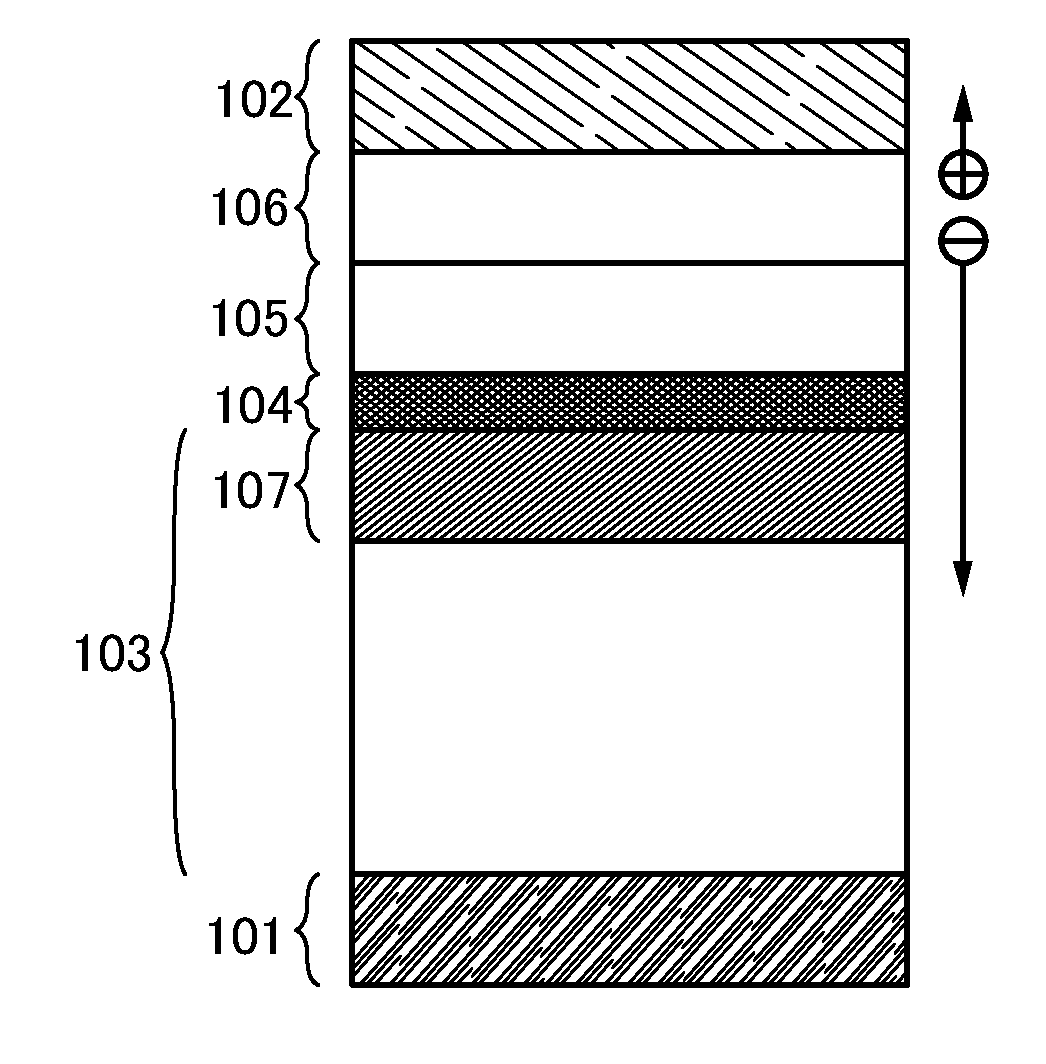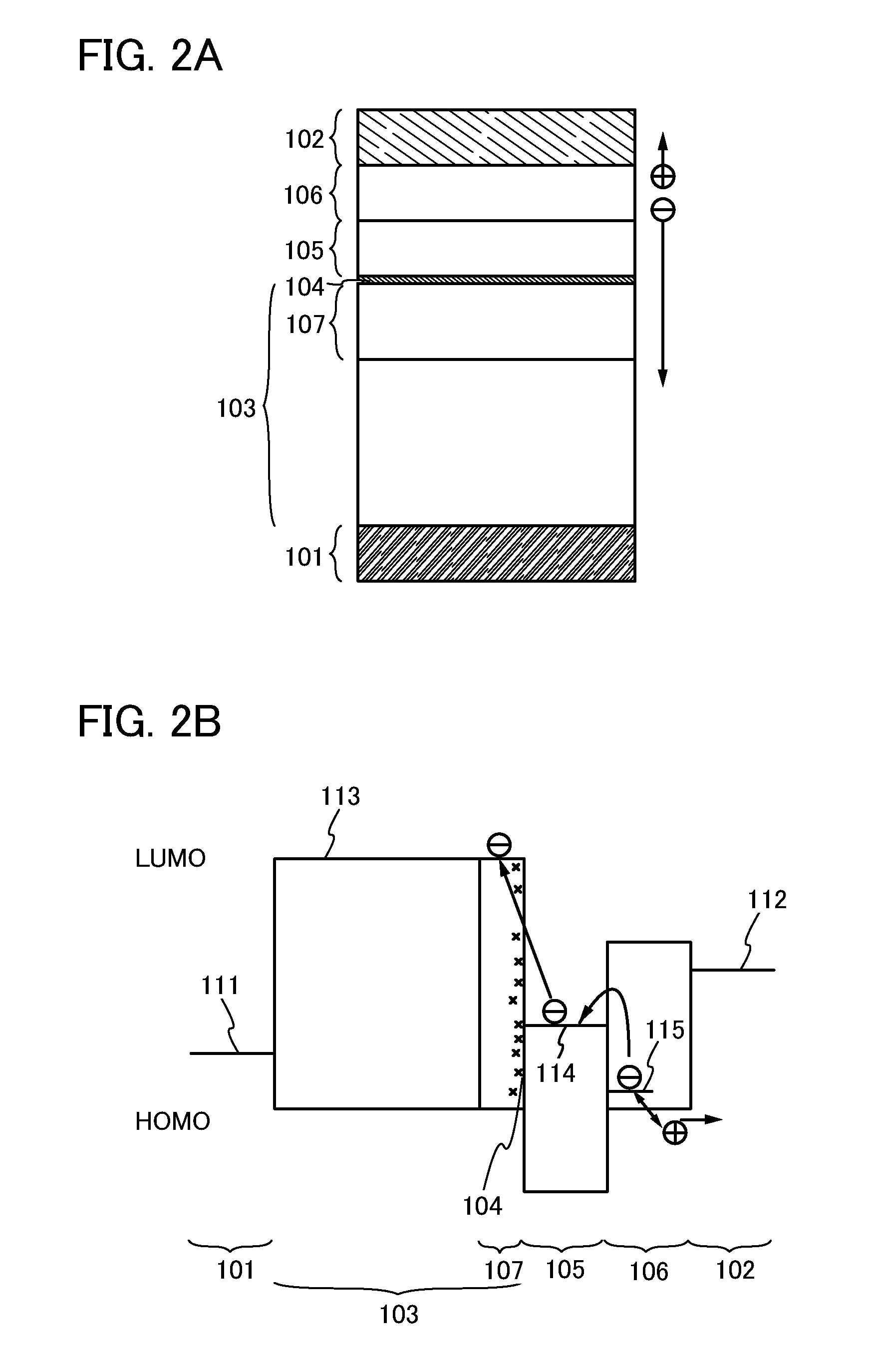Light-emitting element, light-emitting device, electronic device, and lighting device
- Summary
- Abstract
- Description
- Claims
- Application Information
AI Technical Summary
Benefits of technology
Problems solved by technology
Method used
Image
Examples
embodiment 1
[0060]Embodiment 1 will describe an element structure of a light-emitting element according to one embodiment of the present invention with reference to FIGS. 1A and 1B.
[0061]In an element structure illustrated in FIG. 1A, an EL layer 103 including an emission region is disposed between a pair of electrodes (an anode 101 and a cathode 102), a charge production region 106 as a first layer which enables carrier production, an electron-relay layer 105 as a second layer which receives and passes on electrons produced in the charge production region 106, and an electron-injecting buffer 104 as a third layer which injects the electrons received from the electron-relay layer 105 into the EL layer 103 are sequentially stacked from the cathode 102 side between the cathode 102 and the EL layer 103.
[0062]In addition, in the charge production region 106, holes and electrons are produced as carriers of the light-emitting element, and the holes move into the cathode 102 and the electrons move int...
embodiment 2
[0105]In Embodiment 2, an example of the light-emitting element included in the basic structure described in Embodiment 1 will be described with reference to FIGS. 2A and 2B.
[0106]As illustrated in FIG. 2A, in a light-emitting element described in this embodiment, the EL layer 103 including a light-emitting region is disposed between a pair of electrodes (the anode 101 and the cathode 102), and between the EL layer 103 and the cathode 102, the charge production region 106, the electron-relay layer 105 and the electron-injecting buffer 104 are stacked in this order from the cathode 102 side.
[0107]The anode 101, the cathode 102, the EL layer 103, the charge production region 106, and the electron-relay layer 105 in Embodiment 2 can be formed using materials similar to those described in Embodiment 1.
[0108]In addition, as a substance used for the electron-injecting buffer 104, the following can be given: substances having a high electron-injecting property, such as alkali metals such a...
embodiment 3
[0114]In Embodiment 3, an example of the light-emitting element included in the basic structure described in Embodiment 1 will be described with reference to FIGS. 3A and 3B.
[0115]As illustrated in FIG. 3A, in a light-emitting element described in this embodiment, the EL layer 103 including a light-emitting region is disposed between a pair of electrodes (the anode 101 and the cathode 102), and between the EL layer 103 and the cathode 102, the charge production region 106, the electron-relay layer 105, and the electron-injecting buffer 104 are stacked sequentially from the cathode 102 side. In addition, the electron-injecting buffer 104 contains a high electron-transporting substance and a donor substance.
[0116]Note that, in this embodiment, the donor substance is preferably added so that the mass ratio of the donor substance to the high electron-transporting substance is from 0.001 to 0.1:1. Accordingly, the electron-injecting buffer 104 can function as electron-injecting buffer.
[0...
PUM
 Login to View More
Login to View More Abstract
Description
Claims
Application Information
 Login to View More
Login to View More - R&D
- Intellectual Property
- Life Sciences
- Materials
- Tech Scout
- Unparalleled Data Quality
- Higher Quality Content
- 60% Fewer Hallucinations
Browse by: Latest US Patents, China's latest patents, Technical Efficacy Thesaurus, Application Domain, Technology Topic, Popular Technical Reports.
© 2025 PatSnap. All rights reserved.Legal|Privacy policy|Modern Slavery Act Transparency Statement|Sitemap|About US| Contact US: help@patsnap.com



